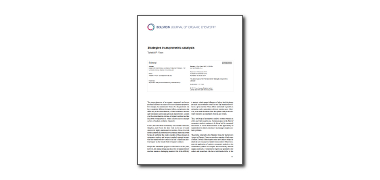Search results
Search for "biodegradable" in Full Text gives 58 result(s) in Beilstein Journal of Organic Chemistry.
Preparation of mixed trialkyl alkylcarbonate derivatives of etidronic acid via an unusual route
Beilstein J. Org. Chem. 2012, 8, 2019–2024, doi:10.3762/bjoc.8.228
- as biodegradable prodrugs of etidronate [11]. Previously, we also synthesized the first phosphorous end-modified alkyl carbonate derivative of HEBPA by a surprising route [18]. According to a SciFinder search, this is the only reported phosphorous end-modified BP carbonate derivative in the
- biodegradable derivatives of BPs. One rather straightforward way to improve the lipophilicity of these compounds is to prepare alkyl carbonate derivatives of BPs. Alkyl carbonate derivatives of phenol and naphthols have been reported to undergo chemical and enzymatic hydrolysis [21][22] and so they have been
Restructuring polymers via nanoconfinement and subsequent release
Beilstein J. Org. Chem. 2012, 8, 1318–1332, doi:10.3762/bjoc.8.151
- recently observed that PVAc coalesced from its IC formed with host urea (U) behaves quite similarly to PVAc coalesced from its γ-CD IC [72]. Coalesced semicrystalline polymers Poly(ε-caprolactone) (PCL) is a biodegradable/bioabsorbable aliphatic polyester that is often used in biomedical applications, such
- nucleant, the semi-crystalline morphology of PCL may be controlled. Of course, not only is the c-PCL nucleant necessarily nontoxic and biodegradable/bioabsorbable, it is also chemically compatible and has a “stealthy” nature. Bulk, as-received poly(ethylene terephthalate) (asr-PET) has been observed to
- obtained by first forming its IC with α-CD, followed by coalescence of the guest diblock copolymer chains, a readily biodegradable sample of the block copolymer with very low crystallinity was produced [16]. Compression molding between Teflon plates produced film samples of asr- and c-PCL-b-PLLA, PCL and
Superstructures with cyclodextrins: Chemistry and applications
Beilstein J. Org. Chem. 2012, 8, 1303–1304, doi:10.3762/bjoc.8.148

- macrocyclic cucurbiturils, CDs show a better solubility in water. On top of that, they are also biodegradable. Considering the importance of CDs as demonstrated above, we felt encouraged to summarize some of the latest results achieved in CD research. Contributions from leading research groups dealing with
Cyanoethylation of the glucans dextran and pullulan: Substitution pattern and formation of nanostructures and entrapment of magnetic nanoparticles
Beilstein J. Org. Chem. 2012, 8, 551–566, doi:10.3762/bjoc.8.63
- edible, biocompatible and biodegradable [28][29]. Several applications in pharmaceutical and food technology have been reported. A summary for biotechnological applications of pullulan is given by Leathers [30]. Dextran is also a microbial glucan, e.g., from Leuconostoc mesenteroides. The main chain is α
ROMP-Derived cyclooctene-based monolithic polymeric materials reinforced with inorganic nanoparticles for applications in tissue engineering
Beilstein J. Org. Chem. 2010, 6, 1199–1205, doi:10.3762/bjoc.6.137

- materials with a specific surface structure and porosity, however, would allow for the differentiation of mesenchymal stem cells into osteoblasts, and thus the development of scaffold materials for bone regeneration. Ideal biomaterials for bone TE should be non-immunogeneic, biodegradable, highly
Ru-catalyzed dehydrogenative coupling of carboxylic acids and silanes - a new method for the preparation of silyl ester
Beilstein J. Org. Chem. 2008, 4, No. 27, doi:10.3762/bjoc.4.27
- greatly due to biomedical field and environmental concerns [2][3][4]. Obviously, silyl esters are very important intermediates for the preparation of easily degradable functional poly(silyl ester)s, widely utilized as gene delivery carriers, matrices for drug delivery, biodegradable surgical devices, and
Unexpected degradation of the bisphosphonate P-C-P bridge under mild conditions
Beilstein J. Org. Chem. 2008, 4, No. 7, doi:10.1186/1860-5397-4-7
- in vitro several different etidronate and alendronate derivatives to act as biodegradable prodrugs of these drugs [16][17][18][19][20][21][22][23]. During our ongoing study to prepare new, possibly bioreversible BP derivatives, we observed unexpected degradation of the P-C-P bridge under mild
- introduction, the P-C-P bridge of BPs has been reported to be relatively stable against chemical hydrolysis, however here we report the unexpectedly easy degradation of two etidronate derivatives into acetate and phosphite moieties. In our ongoing study to prepare novel biodegradable BP derivatives, a new
Synthesis of novel (1-alkanoyloxy- 4-alkanoylaminobutylidene)-1,1-bisphosphonic acid derivatives
Beilstein J. Org. Chem. 2006, 2, No. 2, doi:10.1186/1860-5397-2-2
- hydrophilic, highly anionic and their bioavailabilities are very poor. [12][13][14] It would be a clear advance to prepare more lipophilic and biodegradable derivatives of BPs. A rather straightforward method to improve the lipophilicity of amino BPs is to convert hydroxyl or/and amino group or the phosphonic
- acid groups with a biodegradable ester or amide functionality. Our group has designed, synthesized and studied in vitro several different clodronate (R1 = R2 = Cl, Figure 1) and etidronate (R1 = CH3 R2 = OH, Figure 1) ester and amide derivatives to act as biodegradable prodrugs. [15][16][17][18][19] We




















![[Graphic 3]](/bjoc/content/inline/1860-5397-8-151-i3.png?max-width=637&scale=1.063638) conformations of PET [76].
conformations of PET [76].



































